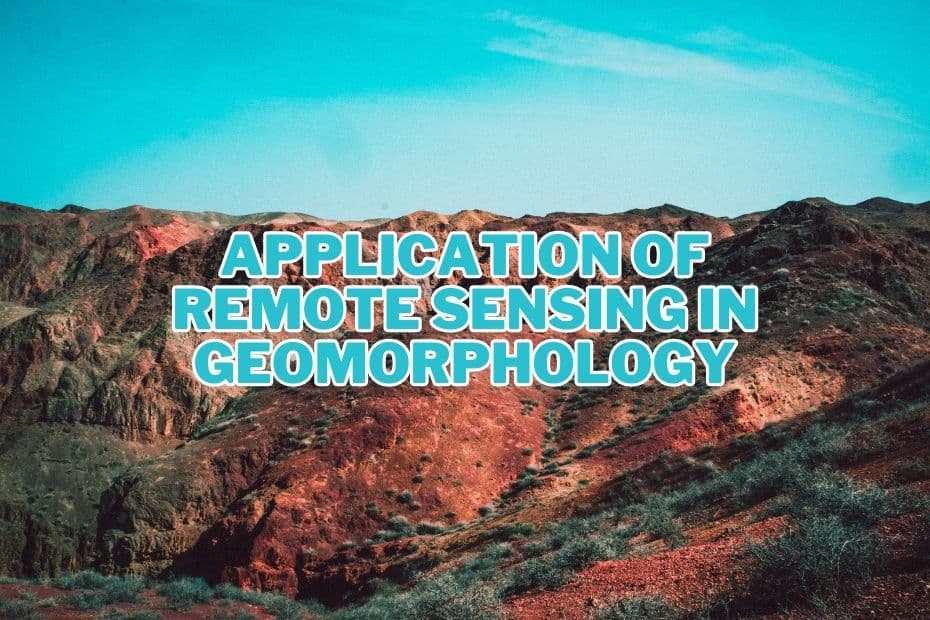In the field of geomorphology, remote sensing has revolutionized the way we study and understand the Earth’s surface. By utilizing various imaging techniques from a distance, remote sensing provides valuable insights into the processes and features that shape our landscapes. This article explores diverse application of remote sensing in geomorphology, highlighting its significance in unraveling the mysteries of our planet.
Through the use of satellite imagery and aerial sensors, remote sensing enables scientists to study and analyze topographic features, land cover changes, erosion patterns, and the impact of natural disasters on landscapes.
Application of Remote Sensing In Geomorphology
In the realm of Earth science, geomorphology has reaped the benefits of technological advances, particularly the application of remote sensing. The utilization of remote sensing in geomorphology provides a panoramic perspective, offering an in-depth understanding of the Earth’s physical attributes. This technology has profoundly influenced numerous studies, from analyzing landforms to assessing geohazards.
1. Landform Classification
Remote sensing enables accurate landform classification by analyzing topographic variations and surface characteristics. By employing digital elevation models and multispectral imagery, researchers can identify and classify different landforms such as mountains, valleys, plateaus, and coastal features.
2. Change Detection
Monitoring landscape changes is essential for understanding dynamic processes. Remote sensing facilitates change detection by comparing images captured at different time intervals. This technique aids in identifying erosion, deposition, vegetation growth, and other transformative events occurring in geomorphic environments.
3. Slope Stability Analysis
Assessing slope stability is crucial for predicting landslides and mitigating associated risks. Remote sensing provides valuable data for slope stability analysis by mapping terrain features, analyzing land cover patterns, and identifying potential instabilities based on surface characteristics and vegetation distribution.
4. Hydrological Studies
Remote sensing plays a pivotal role in hydrological studies by examining water bodies, river networks, and precipitation patterns. It aids in understanding the flow dynamics, water quality, flood mapping, and monitoring changes in hydrological systems over time.
5. Glacial Studies
Studying glaciers and ice sheets is essential for climate change research. Remote sensing techniques like synthetic aperture radar (SAR) and thermal infrared imaging help monitor glacial retreat, mass balance, and ice dynamics, providing critical data for understanding the impacts of global warming.
6. Coastal Zone Management
Coastal areas are prone to erosion, sea-level rise, and other geomorphic changes. Remote sensing assists in coastal zone management by mapping shorelines, monitoring coastal erosion, tracking sediment transport, and assessing the vulnerability of coastal ecosystems to climate-related hazards.
7. Geohazard Assessment
Remote sensing aids in geohazard assessment by identifying potential hazards such as earthquakes, volcanic eruptions, and landslides. It enables the monitoring of active fault lines, volcanic activity, and surface deformation, contributing to early warning systems and disaster management strategies.
8. Archaeological Studies
Remote sensing plays a vital role in archaeological studies by identifying buried archaeological features and mapping ancient landscapes. Techniques like aerial photography, LiDAR, and multispectral imaging assist in uncovering hidden sites, monitoring archaeological sites’ conditions, and aiding in cultural heritage preservation.
9. Urban Planning
Remote sensing supports urban planning by providing accurate spatial data for land use mapping, infrastructure development, and urban growth monitoring. It helps urban planners assess environmental impacts, plan transportation networks, and make informed decisions regarding sustainable urban development.
10. Vegetation Analysis
Assessing vegetation dynamics is crucial for ecological studies. Remote sensing allows for the monitoring of vegetation health, species distribution, and biomass estimation. By analyzing spectral reflectance and vegetation indices, researchers can track changes in vegetation patterns and detect stress-induced alterations.
11. Soil Erosion Mapping
Soil erosion poses significant challenges to land management and agricultural practices. Remote sensing assists in soil erosion mapping by identifying vulnerable areas, quantifying soil loss, and evaluating the effectiveness of erosion control measures. This data aids in developing sustainable land management strategies.
12. Geological Mapping
Remote sensing techniques facilitate geological mapping by providing detailed information about rock types, geological structures, and lithological variations. It aids in identifying mineral deposits, mapping fault lines, and understanding the geological history of an area.
Conclusion
Remote sensing has revolutionized the field of geomorphology, enabling scientists to explore and understand Earth’s landscapes like never before. By harnessing the power of various imaging techniques, remote sensing has proven invaluable in applications such as landform classification, change detection, slope stability analysis, hydrological studies, glacial research, coastal zone management, geohazard assessment, archaeological studies, urban planning, vegetation analysis, soil erosion mapping, and geological mapping.
With continued advancements, remote sensing will undoubtedly contribute to further discoveries and advancements in the field of geomorphology.
FAQs: Application of Remote Sensing In Geomorphology
How does remote sensing help in geohazard assessment?
Remote sensing can detect minute changes in the Earth’s physical attributes, making it an excellent tool for identifying potential risks such as earthquakes, landslides, and volcanic activities.
What is the importance of remote sensing in urban planning?
Remote sensing provides detailed terrain data, identifying suitable areas for expansion, assessing environmental impacts, and assisting in infrastructure planning.
How does remote sensing help in glacial studies?
Remote sensing aids in glacial studies by providing data on glacial retreat, ice dynamics, and mass balance, offering insights into the impacts of climate change on glaciers.
